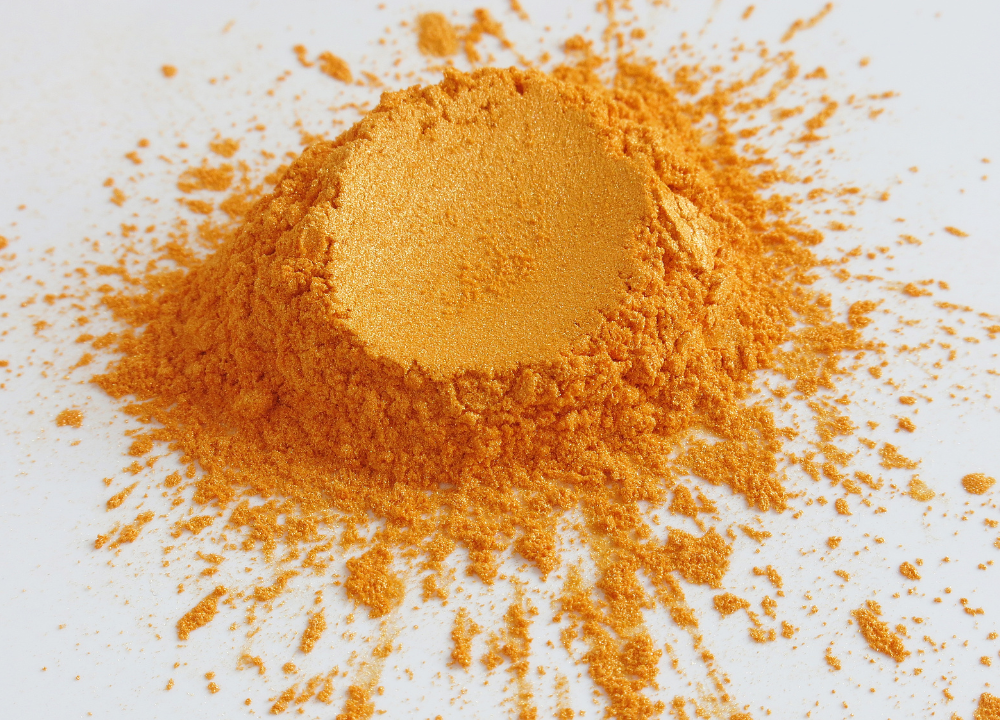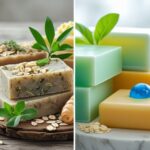Mica is a natural mineral used in soap making to add shimmer and color. Its role lies in beautifying soaps with its pearlescent effect.
Mica’s inclusion in the soap-making process revolutionizes the aesthetic appeal of the final product. As a versatile ingredient, mica powders come in a broad spectrum of colors, enabling artisans and manufacturers to customize soap hues to their preference. Not only does it serve a decorative function, but it also blends well without affecting the soap’s structural integrity.
Crafters often choose mica for its non-toxic property, making it a safe option for skin-contact products. Its popularity in the handmade cosmetic industry is largely due to the vibrant and enchanting visuals it provides. Adopting mica in soap production gives creators an edge in a competitive market, catering to consumers’ desire for visually stunning and unique bath products.
Properties Of Mica
Understanding the properties of mica is essential for its effective use in soap making. Recognized for its shimmer and ability to add a decorative twist, mica’s properties make it an invaluable ingredient. Let’s delve deeper into what makes mica a key player in the art of soap crafting.
Physical Properties Of Mica
Mica is a mineral known for its unique features:
- Color Variability: It comes in various colors.
- Luster: Mica has a natural shimmer or sparkle.
- Translucency: Allows light to pass through, giving a sheer effect.
- Cleavage: Splits easily into thin sheets.
- Elasticity: Flexible and can be shaped with ease.
These physical traits make it popular in soap making, where aesthetics matter greatly.
Chemical Properties Of Mica
The chemical composition of mica includes:
Elements: Primarily aluminum, potassium, and silica.
Stability: It’s chemically stable and does not react with most substances.
Insoluble: Does not dissolve in water, making it ideal for soap.
These properties ensure that mica stays intact and maintains its sparkle in soap.

Types Of Mica
Every shade and sparkle in soaps often comes from a special ingredient: mica. Understanding the types of mica is crucial for crafting eye-catching soaps.
Natural Mica
Natural mica is a mineral found deep in the earth. Soap makers love it for its glittery luster. Here’s why:
- Safe for skin: It adds a gentle shimmer without irritation.
- Variety of colors: From golds to greens, it offers a rainbow.
- Heat-resistant: It stands up to soap-making temperatures.
Synthetic Mica
Some choose synthetic mica, also known as fluorophlogopite. It’s lab-made but shares many benefits:
- Brighter and purer: Colors pop more in synthetic mica.
- Eco-friendly: It reduces mining impact on earth.
- Consistent quality: Every batch has the same sparkle.
| Feature | Natural Mica | Synthetic Mica |
|---|---|---|
| Origin | Earth-mined | Lab-created |
| Color Range | Wide | Wider and brighter |
| Eco-Friendly | Varies | Higher |
| Heat Resistance | Good | Excellent |
Whether choosing natural or synthetic, mica adds the perfect twinkle to handmade soaps.
What Color Is Mica
Exploring the Hues of Mica in Soap Crafting
Mica: a wonder ingredient that artists and crafters adore for its sparkling magic. In the world of soap making, mica plays the star role, adding luster and depth to handmade soaps. But what exactly is the color range of this versatile mineral? From shimmering silver to lush greens and vibrant reds, mica’s palette is as diverse as it is dazzling. Let’s dive into the vibrant spectrum that mica brings to soap crafting.
Silver
Silver mica mirror-like glitter. It infuses soaps with a metallic sheen, imitating the elegance of moonlight. Perfect for creating an air of sophistication in soap bars.
Gold
Gold mica exudes luxury. With golden flecks, it imparts a warm glow, reminiscent of sunlight dancing on water. Ideal for soaps intended to exude wealth and warmth.
Brown
Brown mica earth and nature. It lends a naturalistic touch to soaps, mimicking the hues of soil, wood, and sand, for a grounded, rustic feel.
Red, Green, Blue, And Other Variations
- Red mica – Passion and intensity. It paints soaps in the colors of fire and roses.
- Green mica – Serenity and life. It brings the calmness of forests into bath times.
- Blue mica – Calm and collected. It captures the essence of the ocean’s depths and the sky’s expanse.
- Other Variations: Mica doesn’t stop at basic colors. It embraces the entire rainbow, allowing soap creators to imagine and realize a limitless array of designs.

Uses Of Mica
Mica is a naturally occurring mineral.
It plays a vital role in creating shimmering effects in various products.
Mica In Cosmetics
Mica pigments enhance beauty products.
- Lipsticks contain mica for a pearl-like shine.
- Eyeshadows use mica for their glittery appeal.
- Face powders and blushes contain mica for a smooth finish.
Mica In Art And Crafts
Mica pigment is a favorite in art supplies.
- It adds sparkle to paint creations.
- Scrapbook enthusiasts use mica for a hint of gloss.
- Clay artists mix mica into their creations for effects.
Mica In Electrical Insulation
Mica is a key component in electrical systems.
- It insulates wires in electronics.
- Mica sheets protect against heat and electricity.
- Its resistance to high temperatures is crucial.
Mica In Soap Making
The art of soap making has evolved over the years with a wide selection of ingredients that can add color, texture, and a touch of luxury to the final product. One such ingredient that stands out is mica. Mica is a mineral that, when ground into powder form, is used to add a shimmering appearance to soaps and other cosmetic products. Its use in soap making has become increasingly popular for the unique properties it brings to the table.
Role Of Mica In Soap Making
When it comes to soap making, mica serves as a colorant. Unlike dyes and pigments that can bleed or migrate in soaps, mica remains suspended within the soap itself. Here’s how mica works:
- Mica powder disburses in the soap mixture, offering a vast palette of hues.
- It provides a pearlescent or metallic finish depending on the type of mica and its use.
- Stabilizes color, helping the soap maintain its look over time.
Benefits Of Using Mica In Soaps
Mica isn’t just popular for its beauty; it has other notable benefits:
| Benefit | Description |
|---|---|
| Versatility | Works with a variety of soap bases, including melt and pour, cold process, and hot process. |
| Skin-Safe | Non-toxic and gentle on the skin, making it suitable for a wide audience. |
| Eco-Friendly Option | Many micas are ethically sourced and have minimal environmental impact compared to synthetic dyes. |
| Consistency | Ensures even color distribution for a professional finish every time. |

How To Use Mica In Soap Making
Delving into the world of homemade soaps, one ingredient often steals the spotlight – mica. Mica adds shimmer and color to soap bars, turning an ordinary bath into a sparkly experience. Understanding how to leverage mica in soap making can transform your soapy creations into works of art.
Choosing The Right Type Of Mica
Mica comes in various forms, each offering different benefits:
- Natural Mica – Perfect for a subtle sheen.
- Synthetic Mica – Known as fluorphlogopite, offers vibrant colors.
- Pigment-coated Mica – Delivers intense hues and sparkle.
Always select skin-safe mica for soap making. Check suppliers for cosmetic-grade mica that’s approved for use in skincare products.
Adding Mica To Soap Recipes
Integrating mica into your soap requires a few simple steps:
- Measure the mica powder.
- Mix mica with a carrier oil like olive or coconut oil.
- Blend the mica-oil mixture into your soap base.
- Pour soap into molds, then let it set.
Use about one teaspoon of mica per pound of soap. This keeps colors bright without oversaturation.
Tips For Using Mica In Soaps
Here are essential tips for a smooth experience:
| Tip | Explanation |
|---|---|
| Test Colors | Small batch tests avoid wasted ingredients and unexpected results. |
| Prevent Clumping | Ensure thorough mixing to avoid specks of mica in your soap. |
| Layering Colors | Use different mica colors in layers for a multicolored effect. |
Remember, heat can affect mica colors. Keep temperatures moderate when working with mica to maintain the desired effect.
Frequently Asked Questions
What Is Mica Used For In Soap Making?
Mica is a mineral used in soap making to add shimmer and color. It is a safe, non-toxic ingredient. Soap makers value mica for its vibrant hues and pearlescent shine, enhancing the soap’s visual appeal.
How Does Mica Affect Soap Quality?
Mica does not affect the cleansing properties of soap. Its role is purely aesthetic, contributing to the soap’s color and shimmer without altering its effectiveness. Mica is stable in soap formulations and remains consistent in color over time.
Is Mica In Soap Eco-friendly?
Mica used in soap can be sourced sustainably, but concerns exist regarding ethical mining practices. Some soap makers opt for synthetic mica, which is lab-made, to ensure an eco-friendlier and ethical product without natural mica’s environmental and social issues.
Can You Make Soap Without Mica?
Yes, soap can be made without mica. Alternatives like clays, herbs, spices, and oxides are used for adding color to soap. These give a range of natural tones and are popular choices for those avoiding synthetic colorants.
Conclusion
Mica’s magic in soap crafting cannot be overstated. It adds shimmer, depth, and an aesthetic appeal that elevates a simple bar to a luxurious experience. As we’ve explored, its versatility and safety make it a favorite among artisans. Embrace mica for a touch of sophistication in your homemade soaps.
Keep experimenting and remember, the perfect sparkle is just a pinch away!











